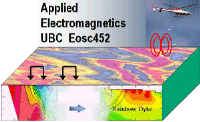 |
Journals for Eosc452: 2006
|
Every student is required to work on a learning journal during the term. In Eosc451 you were asked to
identify 3 goals you hoped to achieve and write entries with these in mind. This time we want you to choose a subdiscipline of geophysics and use the journal entries to relate content and work in this course to that area of interest.
Why Journals? Because it
is well known that a higher level of learning is attained when the learner reflects
on facts, procedures, skills, applications, and other course content. Reflection means thinking about the material within a self-imposed context, rather than simply
working to reproduce information for tests or lab assignments. Previous students
in eosc351 and eosc451/452 have started out considering journals a chore. However,
most found that journalling did in fact provide them with a deeper appreciation
for how the subject will impact them as professionals.
- In week 1, choose a sub-discipline of geophysics that you are particularly
interested in. Examples are: hydrogeology, oil/gas exploration, mineral exploration,
archeology, environmental site characterization, geotechnical engineering,
scientific earth sciences and others.
- Write an initial entry introducing your interests in the earth sciences,
and outlining how you hope this course might contribute to those interests.
- This first entry is due 1 week after the first lecture.
- Before the midterm break, write 3-4 journal entries on how material learned
during this course impacts your chosen discipline.
- Before the end of term, write 2-4 more entries.
- Your last journal entry must summarize how this course has affected your understanding of how geophysics can contribute in your chosen area of the geosciences.
- Each entry should be roughly one page, plus
figures or sketches if appropriate.
- Here are a few examples of possible entries. Variety of entry type is important so don't write all your journal entries in the same way.
- Describe how the current new content might apply to a hypothetical problem
in your discipline.
- Discuss a problem that might be encountered if the current new technique
is applied to a problem in your discipline. Examples include
- noise sources,
- depth penetration problems,
- a discrepancy between the method's resolution and the target dimensions,
- incompatibility between physical properties of the problem and those
the method responds to.
- Summarize a paper you have read that illustrates how material from our
course applies to a problem in your discipline.
- Reflect upon whether the material you are learning appears to be useful
for your chosen discipline.
- Journals may be electronic or hand written, but legibility is of course
important. Hand drawn sketches illustrating a point, scanned or photocopied
images, etc. are encouraged.
- Marking: Here's how to target a particular grade for the journal portion
of your final mark:
- D = fewer than minimum number of entries; half-hearted attempts
at completeness and consistency, no use of the literature at all.
- C = Minimum number of entries (the initial entry plus 6 more),
adequate attention to presentation details, only two or three types of entries
(four types are suggested above), little or no reference to current literature.
- B = Between 6 and 8 entries, clear presentation style, more than
three types of entries (four types are suggested above), referencing is
adequate, at least one reference to current literature or journal articles.
- A = Between 8 and 10 entries, exceptional attention to details
of presentation, accuracy and referencing, several imaginative types of
entries, including references to 3rd party literature and/or
journal articles.
An example of an early journal entry is given here.
© UBC EOS, Jan 2006.

